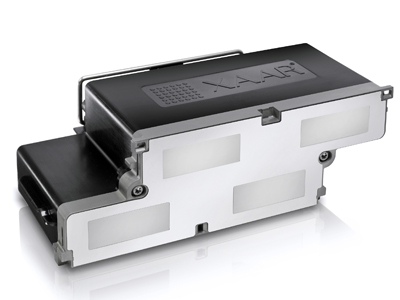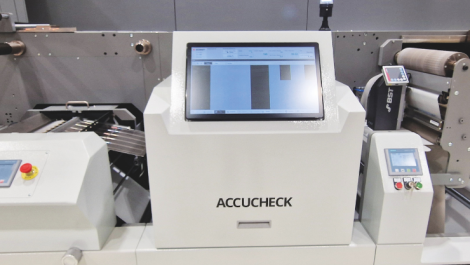Xaar 5601 3p0 printhead
Inkjet presses contain printheads that deliver the individual ink drops to make up the printed image. They are a critical part of any inkjet press and there is a wide choice available. By Sean Smyth.
All printheads comprise an array of nozzles that deliver the ink, with ink supply, usually including filters and temperature control and the electronic connectors to control each nozzle. There are three categories of heads used in production print systems:
• Continuous (from Kodak) where ink passes through the nozzle in a continuous stream and non-printing drops are recovered;
• On-demand piezo where drops are ejected by a pressure wave generated by applying an electrical impulse to a material that causes it to flex and change shape; and
• Thermal (from HP) where ink is rapidly heated in a chamber, thepressure-rise forcing a drop to be ejected.
While suppliers of each type will explain why their system is the best, the reality is that all work, reliably delivering high volumes in high quality. All heads deliver many thousands of very small drops per second from hundreds or thousands of nozzles. Forming consistent drops with no small satellites is important, along with the jetting straightness. Heads must perform at this standard over the life, which should be over years of continuous operation often in unfavourable conditions with paper dust and high humidity.

Components of the Kodak Stream printheads
The enemy of inkjet is blocked nozzles that can lead to noticeable white lines in the print. This can be from particles in the ink, dried or semi-dried ink around the nozzle, air bubbles or dust and debris from the operating environment. A popular way of minimising this effect in piezo heads is to use a recirculating ink design, where ink continually circulates through the actuator chambers of the printheads in use. This helps to prime the chambers, remove air bubbles and reduce any tendency for pigment to settle, with fresh ink always presented to the nozzles which helps reduce cleaning and maintenance.
The head has to be compatible with the ink in use. This involves long-term print testing to ensure there are no adverse properties on the head, and the manufacturer will guarantee the heads against failure in use. For this, the head provider may charge a royalty payable by the ink supplier.
Resolution
Manufacturers provide the native resolution of the head (the distance between adjacent nozzles), which are typically 360, 600 or 1200dpi. While this is one indicator of the achievable print quality, it is not the key determinant. Quality is a result of the consistency of jetting and how the drops are formed. Head manufactures provide details of the ink drop size, the frequency of droplet generation, but the way the drops are generated is critical in delivering good quality.
Printheads can be used in binary mode, where every drop is the same size, or they may run in greyscale mode where drops can range in size. The number of grey levels is the number of different dot sizes that can be printed including white, ie no dot. The variable sized dots are made up of individual droplets that coalesce in flight into a single drop. The number of levels depends on the driver mechanism employed; it is commonly four, six or eight. Using greyscale gives much better quality than binary at the same native resolution, smoother gradations and much better clean edges on text.
The drawback in using greyscale is that each printing dot is made up of a combination of several individual drops. If a head prints at 50kHz, it delivers 50,000 individual drops per second. At a resolution of 600 x 600dpi, the substrate can move at the length of 50,000 drops each second (which is 50,000/600 = 83.33 inches per second, or 127m/min). However, using greyscale printing means multiple drops make each printing dot, so speed is limited. With five grey levels at 600dpi from the same head, it would be a nominal 10,000/600 = 16.66 inches per second or just 25.4m/min. Equipment suppliers will usually allow users to vary the mode of operation of the head in use, adjusting the resolution to allow the optimal balance of speed and quality. The key point is that the highest resolution does not necessarily mean the best result.
Front end power
At higher resolution the data load to the head is higher, so needing a more powerful digital front end and powerful electronics to drive each nozzle of each head in a system that can be up to 2.8m in width, with multiple colours. The equipment manufacturer may design and program the electronics, or they could use software provided by specialist control companies, such as Global Inkjet Systems. It develops industrial inkjet software, drive electronics, components and services and has a single scalable platform for driving a wide range of printheads. The core of the platform is the GIS Print Manager Board, which allows customers to switch printhead technology, using the appropriate GIS head interface board. GIS is based in Cambridge, as is Meteor Inkjet Ltd, which also supplies printhead drive electronics and software under the Meteor brand since 2006. It was founded by the TTP (the Technology Partnership), but was bought by Global Graphics in 2016.
The printhead drive electronics translate RIPped artwork files into the signals used by the printheads to fire drops when and where they are needed, the datapath. The primary task of the datapath is to process a great deal of data to and from multiple printheads, each having hundreds or thousands of nozzles that fire tens of thousands of drops per second. In addition to this fundamental requirement, the electronics must cope with complicating factors, including but not limited to correcting for mechanical inaccuracies, masking printing to match product shape and orientation, dealing with printhead non-linearity, managing zero-gap printing, compensating for missing nozzles and tuning waveforms for specific fluids.
Meteor said it has acquired a deep understanding of the fundamental science and engineering that underpins inkjet printing over many years, accruing a vast amount of expertise in the real-world development of printhead drive electronics. It has long-established relationships with leading head manufacturers and will often be afforded early access to information about new developments so that electronics can be made commercially available as soon as a new printhead is launched. As application demands increase and there are more heads on the market, print system providers value faster time to market while avoiding the investment necessary to develop electronics in-house. Because it is owned by Global Graphics, customers have the option of printing PDF files using a built-in Harlequin RIP, though Meteor remains RIP independent and customers remain free to work with any RIP supplier they choose.
Head manufacturing
Printheads can be complex with many parts assembled together. Manufacturing methods are developing with several suppliers using MEMs techniques borrowed from the silicon chip sector. This requires significant investment in the production facility, but using silicon to fabricate structures in a single pass improves consistency and boosts the yields of good printheads.
There is a lot of choice. Heads may cost several thousand pounds and failures can make a print system uneconomic with replacements and downtime. Despite the claims of head suppliers there is no simple method of determining which is the best head to choose. Equipment developers decide according to their performance/cost criteria. They will build up experience, which is important in making working systems, although they may be reluctant to change as new models come to market. Converters will choose the most suitable printer for their application. Understanding the strengths, and expected lifetime, of the heads should be part of the selection process.
Read the full September/October issue of Digital Labels & Packaging here. Subscribe to the magazine for free – register your details here.






